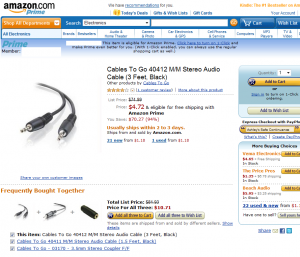3 minutes, 34 seconds
When we consume products in the US, what is the true cost? Most folks would think it’s simply the dollars they shell out of their wallet for the item they just purchased. If it’s just a monetary exchange, then price is king and entirely defines an item’s true cost. You should always pay the lowest amount possible for the highest quality goods.
To that end, Amazon’s native Android app is pretty great. Say you’re in your local widget shop, just down the street and they have Model A Widgets for $59.99. Whip out your phone, scan the bar code and BEEP, you see Amazon has it for $39.99. What’s that? It’s on Amazon Prime too? Sign me up! I get it 2 day shipping and tax free!
What if you’re looking for an audio cable. You could make one out of the spare parts bucket you’ve got in your garage, or you could get shiny new one online for $75.00. But whats this? It’s marked down to $4.72? Well, that’s over a 90% discount, sign me up for that deal too!
What about food? Should I pay triple for an Avocado because it has the “Organic” label on it? No way jose! The ones in the bin right next to it are cheaper and bigger to boot.
If you know me, you know this is not what I believe. I believe that the true cost of that widget includes not only the revenue you deprive your local shop of, but the neighborhood’s loss when it’s full of big box stores. I once was told by a fake cop I couldn’t park my bicycle in front the big box store I was trying to patronize because it wasn’t allowed. See, the entire box store mall setup was on private property, so they could set arbitrary rules that made no sense and then kick you off their property if you ride a bike and park it “funny”. Yes, a bit of a rant, I know, but I consider that the true cost of keeping your local shops in business.
The food has the same true cost. We should ensure our local farmers can make a living wage off the food they sell. Further, we should not by crap that will so pumped full of craziness, including preservatives that last forever. Eating this deprives us of healthy bodies which in turn cost the health care system money to fix.
Sadly, this post has a hypocritical end. I bought the cable. It came two days latter to my office. I suspect there’s some little boy in a sweat shop who doesn’t like me. I could have pulled out my soldering iron, found the scrap cable parts in my wires bucket and pieced together the cable I need. But nope, I just clicked “buy” instead.
Any one know of a good place online to by this sort of item and pay the true cost for it?
Update: One of our fine (few?) readers wrote in:
Interesting post. Here is an article, though a few years old now, that I may have alluded to in the past: Food That Travels Well
It doesn’t address electronics, but food. The main point being that distance itself isn’t the only variable in the “true cost” of something equation, at least environmentally.
Good point! Looking at the true cost inherently means you open the cost equation wider and wider, thus covering more and more factors. In this case, the fact that farmers can’t graze their sheep and are forced to use feed bumps up the net pollution for equation.
This should give us pause to know more about what we consume and what resources that consumption demands. A good, but admittedly hard to find, solution is something like Polyface farms as featured in Michael Pollan’s Botany of Desire. What’s hard to find here is the solution to the massive equation to figure the true cost of eating a good steak. In general, we, as lazy consumers, don’t want to be on the line for counting every carbon footprint, health care cost, and increase in child slavery. Instead, we want a simple, “If I do A, B will happen” type of solution. It doesn’t exist.
Here’s another tip of an iceberg along the lines, of “just do A…”:
The geophysicists Gidon Eschel and Pamela Martin have estimated that if every American reduced meat consumption by just 20%, the greenhouse gas savings would be the same as if we all switched from a normal sedan to a hybrid Prius – Meat: Making Global Warming Worse
There’s a great exhibit at the Academy of Science that explores this fact and demonstrates it in a way that even a 10 year old can grok.
More food for thought, indeed! Also, I very thoroughly checked the “Rambling” category in this update too ;)
